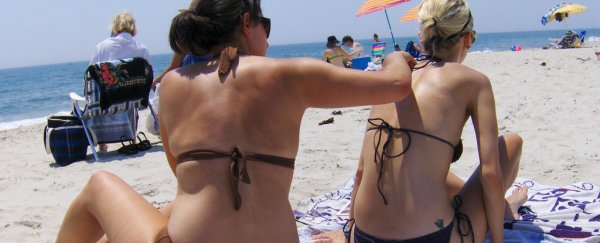Traditional sunscreen works by reflecting harmful ultraviolet A (UVA) radiation away from your skin, but a new compound does something even better - it guards your skin cells from the effects of the sun from the inside out.
Offering protection inside the cell where the greatest damage from UVA occurs, this compound is said to offer "unprecedented protection" against skin cancer, and the effects of photoageing, such as sags, wrinkles, and sunspots.
Dubbed the mitoiron claw, the compound clings to the insides of cells, and prevents the kind of iron leakage that's triggered by UVA exposure. If severe enough, this iron leakage can ultimately leads to cell destruction.
To understand why loose iron is such a problem, you need to understand how UVA affects cells. Radiation from the Sun unlocks free radicals - highly active oxygen molecules - in the skin, which then cause damage to DNA, cell membranes, and proteins.
At the same time, it also releases iron from the cell's mitochondria, which depletes the cell's energy supply and causes the cells to produce more free radicals. In other words, UVA causes cells to be killed off, and this can eventually lead to skin cancer.
It also causes skin to sag, wrinkle, and age, as you might have noticed if you spent a lot of time basking in the sunshine as a kid.
To combat this, researchers from the University of Bath and King's College London in the UK developed the mitoiron claw, which is a type of chelator - a compound that binds to an iron atom. This allows it to target iron that's loose in the mitochondria of the cell and prevent the release of extra free radicals.
"The role of iron-mediated damage induced upon exposure of skin cells to UVA has been underestimated for many years," said one of the team, Charareh Pourzand from the University of Bath. "For efficient protection against UVA-induced iron damage of skin strong chelators are needed, but until now these risked toxic effects caused by non-targeted iron starvation of cells."
While the new substance focusses on UVA, protection is also needed against ultraviolet B (UVB) rays, short wave radiation that is even more of a risk when it comes to skin cancer.
The next step is to get the compound into existing sprays and creams with UVB protection. Although the initial mitoiron claw results have been promising, they've only been tested on human cells grown in a lab so far, but the scientists estimate their compound could make it to our sunscreen in three to four years.
"The current sunscreens are not bad, but they can certainly be improved," pharmacologist and lead researcher, Olivier Reelfs from the University of Bath, told Kelsey Kennedy at Quartz.
The researchers' work has been published in the Journal of Investigative Dermatology.
